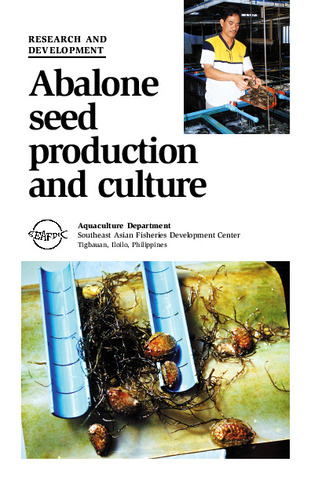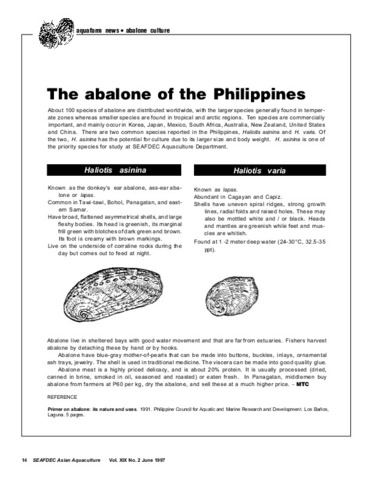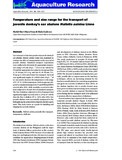Perlihatkan publikasi sederhana
Evaluation of density and cage design for the nursery and grow-out of the tropical abalone Haliotis asinina Linne 1758
| dc.contributor.author | Encena II, Vincent C. | |
| dc.contributor.author | de la Peña, Milagros | |
| dc.contributor.author | Balinas, Vicente T. | |
| dc.date.accessioned | 2015-05-19T08:00:43Z | |
| dc.date.available | 2015-05-19T08:00:43Z | |
| dc.date.issued | 2013 | |
| dc.identifier.citation | Encena II, V. C., de la Peña, M., & Balinas, V. T. (2013). Evaluation of density and cage design for the nursery and grow-out of the tropical abalone Haliotis asinina Linne 1758. Journal of Shellfish Research, 32(1), 21-27. | en |
| dc.identifier.issn | 0730-8000 | |
| dc.identifier.uri | http://hdl.handle.net/10862/2234 | |
| dc.description.abstract | The effect of stocking density and cage design on the growth, survival rate, and feed conversion ratio was evaluated for the nursery (11–15 mm in shell length) and juvenile grow-out (26–30 mm in shell length) of the tropical abalone Haliotis asinina. Abalone were fed Gracilaria sp. within a randomized 2 × 3 factorial experiment using 2 stocking densities (Tl (500 pieces/m2) and T2 (1,000 pieces/m2)) and 3 cages (D1, box; D2, mesh cage; D3, prefabricated multitier trays). In addition, 3 stocking densities (T1, 50 pieces/m ; T2, 100 pieces/m; T3, 200 pieces/m) were evaluated in the prefabricated multitier trays. We found that, in the nursery experiment, 4-mo-old tropical abalone juveniles reared for 90 d showed no significant differences in growth (shell length and body weight) and survival rates among the 3 nursery cages used (Tukey's post hoc test, P > 0.05). Feed conversion ratio, however, was lowest for the high-density treatment T1D3 (7.8 ± 0.76) and was significantly different from the low density treatment T1D1 (11.32 ± 1.2) and intermediate density treatment T1D2 (12.39 ± 1.12; t-test, P > 0.05). Conversely, at higher densities (T2), the same trend applied with abalone reared in multitier basket systems (T2D3), having the highest growth rates and survival rates (29.3 ± 0.07 mm average shell length (ASL) and 5.16 ± 0.52 g average body weight (ABW)), followed closely by those reared in mesh cages (T2D2) and boxes (T2D1). Feed conversion ratio was also lowest for T2D3 (7.56 ± 0.79) and was significantly lower than T2D1 and T2D2. Between treatments, however, abalone reared at lower densities (T1) had significantly higher growth and survival than those reared at higher densities (T2), regardless of the nursery cage used, indicating an inverse relationship between stocking density, growth, and survival. For the grow-out study, tropical abalone reared in multitier trays at low densities (T1) attained the highest growth in shell length and body weight (49.7 ± 0.11 mm ASL and 29.8 ± 2.6 g ABW, respectively) at 180 d of culture, which was significantly greater than those reared in the high-density treatment (T3) with significantly smaller shell length and body weight (43.8 ± 0.18 mm ASL and 21.2 ± 2.0 g ABW), but not significantly different than the intermediate density treatment. This trend started from day 60 of culture onward when analyzed using Duncan's multiple range test (P > 0.05). Survival rates were not significantly different among stocking density treatments, nor were feed conversion ratios. We recommend, for nursery rearing of abalone juveniles, using multitier trays (D3) or boxes (D1) at 500 pieces/m2 stocking density to attain a grow-out size of 26–30 mm in shell length in 90 days. A stocking density of 100 pieces/m2 is recommended to grow abalone in multitier trays to attain a cocktail size of 50 mm ASL and 30 g ABW in 180 d with survival rates between 85.6% and 83.1%. | en |
| dc.description.sponsorship | The study was funded by the Southeast Asian Fisheries and Development Center, Aquaculture Department (SEAFDEC/AQD), under the Technology Verification and Demonstration Division (TVDD), through study codes 5320-T-TV-M0309I and 5302-T-TV-M0311I. | en |
| dc.language.iso | en | en |
| dc.publisher | National Shellfisheries Association | en |
| dc.subject | abalones | en |
| dc.subject | Gracilaria | en |
| dc.subject | Haliotis | en |
| dc.subject | Haliotis asinina | en |
| dc.title | Evaluation of density and cage design for the nursery and grow-out of the tropical abalone Haliotis asinina Linne 1758 | en |
| dc.type | Article | en |
| dc.identifier.doi | 10.2983/035.032.0105 | |
| dc.citation.volume | 32 | |
| dc.citation.issue | 1 | |
| dc.citation.spage | 21 | |
| dc.citation.epage | 27 | |
| dc.citation.journalTitle | Journal of Shellfish Research | en |
| dc.subject.asfa | body size | en |
| dc.subject.asfa | body weight | en |
| dc.subject.asfa | cages | en |
| dc.subject.asfa | feed conversion efficiency | en |
| dc.subject.asfa | growth rate | en |
| dc.subject.asfa | mollusc culture | en |
| dc.subject.asfa | nursery grounds | en |
| dc.subject.asfa | shellfish culture | en |
| dc.subject.asfa | stocking density | en |
| local.subject | Abalone | en |
| local.subject | aquaculture | en |
| local.subject | Gracilaria sp. | en |
| local.subject | Haliotis asinina | en |
| local.subject | Philippines | en |
Files in this item
| Files | Size | Format | View |
|---|---|---|---|
|
There are no files associated with this item. |
|||
Publikasi ini ada di koleksi berikut
-
Journal Articles [1256]
These papers were contributed by Department staff to various national and international journals.



